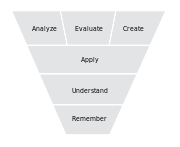Albany Senior High School/Learning/Working with texts
From WikiEducator
Here are some strategies for working with texts:
- For texts with paragraphs, ask students to use a highlighter to identify the single most important sentence in each paragraph. The skills comes in identifying the topic sentence. Justify your choices with a partner.
- Sentence Stubs. Take a passage of about 5-10 paragraphs, number the paragraphs before copying and handing out to students. Get students to read the passage thoroughly, then ask some short-answer questions. Work in groups of 3-4 and score on the board. One point for finding it, one point for a correct answer.
- Predict: present students with 3/4 of a text and get them to say what they think happened next, or how a text ends. Get them to justify their reasoning.
- Ask questions: write questions they know (or don't know) the answer to. Share them with the class to see if they can answer them.
- Summarise a text in exactly 22, 30, 40 words. It doesn't matter what the number is; the skills lies in knowing the text well enough to be able to reduce it down to its essence. Compare your summary with a partner's. Defend your decisions.
- Having read a text, identify the 5/10 most important words and write definitions for them. Uses the higher-order skill of evaluation.
- If a text is a sequential narrative, have students turn this into a flow chart of 4/8/10 steps. Identify the key points of the narrative. When this is done, choose the 3 most important steps and explain why they are important.
- Read a passage and then identify a metaphor that suits the text. For instance, Othello is like a tiger: as the play goes on, the more his jealousy consumes him and those around him like a wild animal like a tiger.
